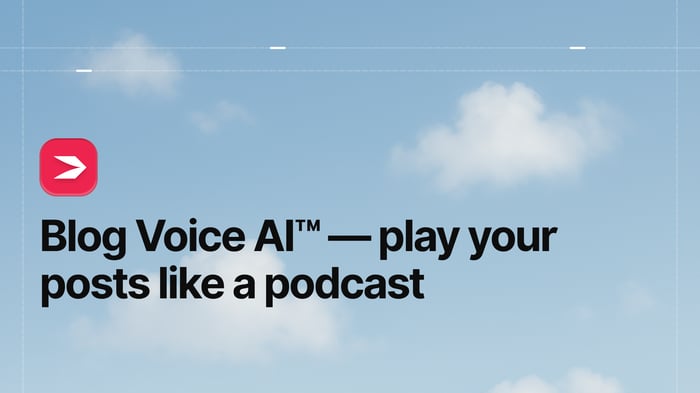ClickFunnels is probably the most popular platform specializing in everything that has to do with funnels. It was launched in 2013, managed to make a name for itself in the following years, and is still very much alive and kicking today – as we'll see in this ClickFunnels 2.0 review.
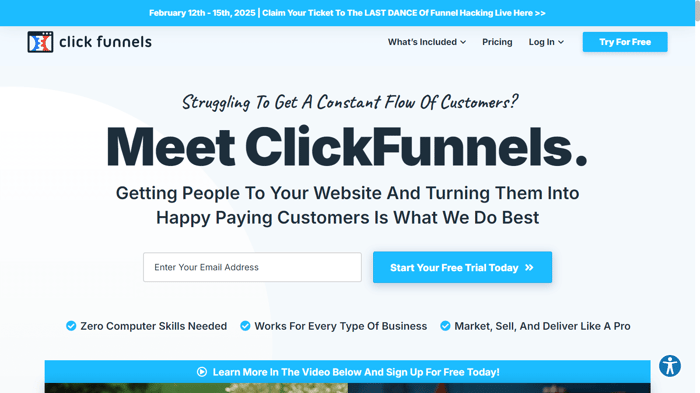
This is not to say that ClickFunnels hasn’t seen rainy days. In fact, you could say that the platform went through a kind of crisis relatively recently.
Table of Contents
Customer Support
People started criticizing its ineffective and slow customer support and complained that it hadn’t introduced any significant change in a long time. Moreover, they showed dissatisfaction with how slow ClickFunnels’ page rendering can be and were fed up with its high prices that some felt were not in line with what the platform offered.
A New Beginning
However, in 2021 things started to change for the better. One of the most important changes ClickFunnels made was introducing live chat support for all of its customers. Their shift in priorities was reflected in the significant increase in the number of customer support staff members.
In turn, the quality of the company’s customer service and the platform generally was noticeably improved. Regardless of how great this may sound, by all accounts it wasn’t even close to the changes we would witness soon after.
ClickFunnels released ClickFunnels 2.0 on October 4, 2022 – an event that shook the business software world once again, even though it was technically a soft launch with no big fireworks.
There was such excitement and anticipation about this new version of ClickFunnels that we just couldn’t ignore it, which is why we decided to write this ClickFunnels 2.0 review. So, if you’d like to find out more about the new version of ClickFunnels, stick until the end of this article, and we’ll explore all the major novelties it brings together.
ClickFunnels 2.0 in a Nutshell
ClickFunnels 2.0 was announced at the Funnel Hacking Live event in September 2021. Those who were lucky enough to attend the event, whether on-site or online, had the opportunity to get a glimpse of the new ClickFunnels version before anyone else.
On top of that, they had a chance to witness the beginning of a new era in the company's history through hands-on experience with the ClickFunnels 2.0 Beta release. In the meantime, the rest of us have learned about the latest version of ClickFunnels through videos and articles published by the company.
At that point, if you signed up for an account through their Help Center, you’d be redirected to the new ClickFunnels 2.0 builder. Now, it’s the other way around – you have to dig deep to find the signup page for ClickFunnels 1.0 (ClickFunnels Classic).
So, What Is ClickFunnels 2.0?
For starters, there’s one thing that Russell Brunson and Todd Dickerson, the ClickFunnels co-founders, made crystal clear: ClickFunnels 2.0 is not simply a beautified and corrected version of the existing ClickFunnels software.
Being developed in React, an extremely popular JavaScript library known for its speed, flexibility, efficiency, and high performance, ClickFunnels 2.0 is an entirely different animal. As Russell Brunson roughly puts it, ClickFunnels 2.0 is ClickFunnels rebuilt from the ground up.
From a slightly different perspective, ClickFunnels 2.0 results from years of collecting and carefully listening to customers’ feedback and turning the insights from that data into a reality that ClickFunnels customers have wished and hoped for.
What Has Changed?
The short answer is – everything. The long answer requires a little more space, time, and explanation.
New Dashboard
The redesigned dashboard is the first and most noticeable difference compared to ClickFunnels 1.0. It now contains a bunch of different (new) menus or sections located on the left side of your screen:

The complete list includes the following sections:
Dashboard
Sites
Funnels
Products
Orders
Contacts
Analytics
Marketing
Payments
These sections are essentially designed to be used almost independently from one another.
For instance, if you have a big enough company to include multiple teams, your analytics team should be focused exclusively on the analytics section, while the marketing team should only work with the marketing section.
You can implement this “division of labor” by granting your teams or particular team members access only to the specific section related to their expertise, assignments, and tasks.
Sites and Funnel Hubs
The Sites section is exciting. As anyone who has entertained the idea of creating a multi-page website on ClickFunnels 1.0 knows all too well, the ability to create a website is not a part of that version’s feature set.
With ClickFunnels 2.0, however, the company seems to have changed its approach to websites. So it has decided to add the ability to build a website to the entrepreneur’s sales and marketing arsenal. That means that in ClickFunnels 2.0, every account includes a site.
Nonetheless, keep in mind that in the new version of ClickFunnels, a website is essentially a kind of an umbrella term for a home page together with a blog, e-commerce storefront pages, the so-called Customer Center (more on that later), and the rest of your pages (for instance, a 404 page).
The more accurate – or at least alternative – name for this entity is a funnel hub. Loosely speaking, you can think of a funnel hub as a multi-faceted website.

As you probably already know, ClickFunnels 1.0 doesn’t include a blog and storefront or, for that matter, any of the other functionalities and pages that you can see in the image above. Now they’re all there and part of the new platform, which we’re sure is music to the ears of many entrepreneurs and marketers.
No matter how exciting this sounds, it’s not even close to everything that you’ll be able to find in your Sites section, i.e., funnel hub.
In addition to the functionalities and pages mentioned above, within your Sites section, you’ll find subsections like Courses, Funnels, Domains, and even more, as you can see in the following image:
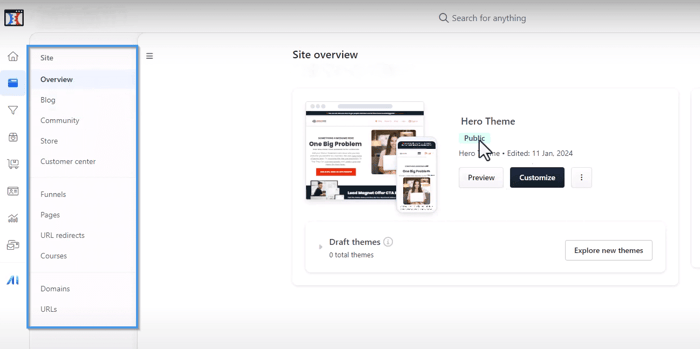
The Sites section contains some of the most important and interesting tools for most users. If they all work as well as they’re supposed to, entrepreneurs will have a blast building and running their businesses on ClickFunnels 2.0.
However, there’s more to ClickFunnels 2.0 than what you saw in this section. That’s why in the next section, we’ll explore some of the tools we haven’t mentioned here and expand on the ones we have.
So, let’s go over some of the most notable ClickFunnels 2.0 features.
The New ClickFunnels 2.0 Features
Funnel Builder
The new funnel builder looks terrific. Two of its most significant advantages are that it allows you to split-test your pages and give different permissions to different team members.
For instance, you can choose to let some of your team members edit your funnels while denying this level of privileged access to others.
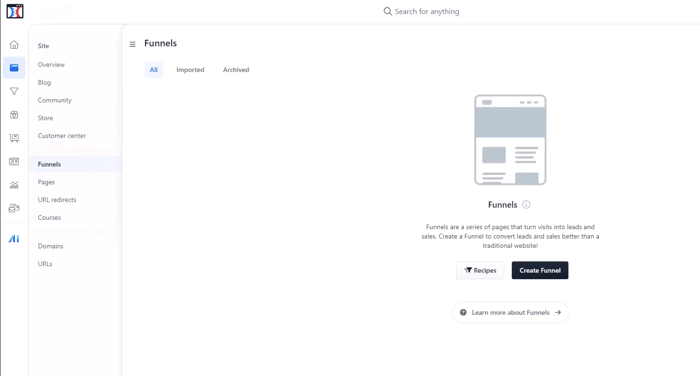
In addition, the new funnel builder supports conditional split-testing, called a conditional split path. Basically, if we got it right, the audience is sent to a page variant based on a certain condition (if this happens, then show this variant; if that happens, then show that variant).
This feature alone makes the new funnel builder a lot smarter and more effective than what you have in ClickFunnels Classic.
Page Editor
Unlike the current editor, the new ClickFunnels page editor allows you to have the same header and footer on all of your pages without manually changing every page to align with your universal site styles. The same applies to your navigation menu.
Static Navigation Menu
In ClickFunnels 1.0, you can’t even have a real navigation menu that stays the same across your multi-page funnel without resorting to time-consuming and complex workarounds for this deficiency. ClickFunnels 2.0 solves this issue, which is excellent news for anyone who has tried to build a multi-page website in ClickFunnels 1.0.
Funnel Flexibility
Furthermore, the new page editor is much more flexible. For instance, switching from one page to another for editing purposes is a breeze when you’re inside a funnel. This is because ClickFunnels 2.0 allows you to see your full funnel in the background while having your page open in the editor. You can click whichever other page you want to edit without closing the current one, which is extremely convenient.
Speaking of pages, in ClickFunnels 2.0, you can create pages independently of any of your funnels, which is not the case in ClickFunnels 1.0. This gives you a lot more control, freedom, and flexibility.
Real-Time Collaboration
Furthermore, the new page editor allows team members to work on a page simultaneously. For instance, you and your designer can make changes simultaneously and see what’s happening and how the changes look in real time, pretty much similar to when you work with your team in Google Docs.
Yet another good news is that the ClickFunnels 2.0 design team added more templates to the ones already available, making the lives of ClickFunnels customers easier.
Page Load Speed
Based on the speed tests done by ClickFunnels, when it comes to page load time, it seems that ClickFunnels 2.0 leaves not just ClickFunnels 1.0 but also the company’s competitors (at least those featured in the tests) far behind:
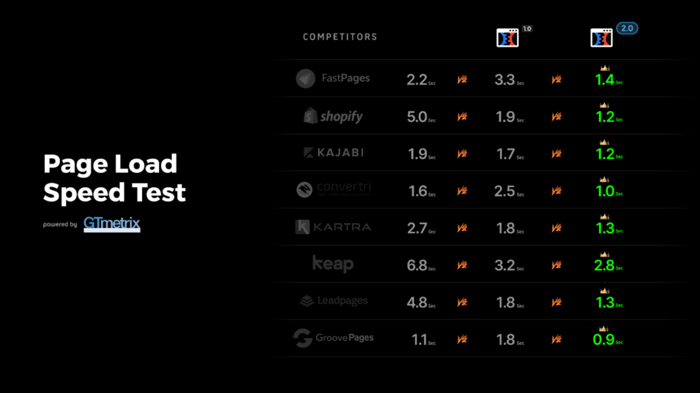
Apart from the way they built ClickFunnels 2.0 and the new technologies that enabled it to work much more effectively than before, one of the secrets of the fast page load time is the use of CDNs (content delivery networks).
The purpose of a CDN is to load web content from a server that’s physically closest to the user, which can dramatically speed up the load time and contribute to a much better user experience.
Yet another positively contributing factor to the fast page load time in ClickFunnels 2.0 is image optimization. Whenever you add an image to your page, ClickFunnels 2.0 optimizes it in real time when loading the page. The adjusted size of the image allows the page to load more quickly.
Blog
In our opinion, the fact that ClickFunnels finally decided to add blogging functionality to its toolkit shows how robust and serious an all-in-one platform ClickFunnels 2.0 can be.
Today, you’d be hard-pressed to find a business that survives and finds success without a solid content marketing strategy and blog, so developing a native blogging solution is one of the best things that ClickFunnels did for its customers.
The ClickFunnels 2.0 blog has a modern, simple, and user-friendly interface, and, as the ClickFunnels co-founder Todd Dickerson claims, it's SEO-optimized “from day one.”
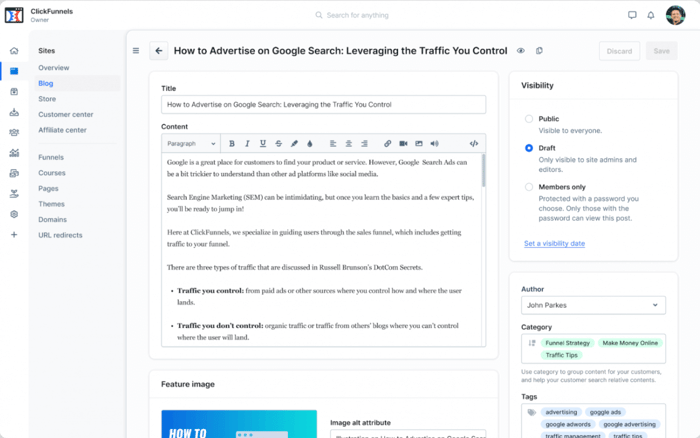
ClickFunnels hasn’t suddenly transformed into a full-fledged blogging platform. In case you find the new blog underwhelming, there are third-party alternatives.
Currently, you can blog on ClickFunnels 1.0 with DropInBlog, and if you decide to create a blog on ClickFunnels 2.0, you can do that, too.
E-Commerce
The newly-added e-commerce functionality enables you to create a complete online store with all the necessary tools and features. ClickFunnels’s idea with the e-commerce functionality is to make their customers’ need for a Shopify (or any other) store builder redundant.
Simply put, this means that on top of the specialized e-commerce tools, ClickFunnels 2.0 allows you to customize your storefront’s look and feel as well.
Another important novelty related to e-commerce is global products. Basically, this new feature allows you to have the same product in as many different funnels as you want. At the same time, you’ll be able to create variations regarding the same product depending on the offering that it’s a part of.
For instance, you can give your product different prices depending on the target audiences, based on whether it’s a part of an upsell or a downsell, and so on. The best part is that this is a built-in feature, so you don’t have to pay extra money or install integrations to include it in your feature set.
Another noteworthy e-commerce feature is offering pre- and post-checkout upsells and creating conditional upsell flows. The latter enables you to have smarter upsell offers, and it works like this: if a customer does A, offer Product A, but if they do B, offer Product B.
Analytics
Thanks to its superb analytics tools, in ClickFunnels 2.0, you can check your funnels' stats in real time and see how they perform – what works and what doesn’t work well.
It goes without saying that, just like any other prominent business software solution, ClickFunnels 2.0 has a separate analytics dashboard as well. In it, you’ll be able to see the numbers related to all aspects of your business built on the platform.
Moreover, the analytics dashboard lets you create and view custom reports showing only the numbers you’re particularly interested in.
Emails
One of the new email-related features worth mentioning is the ability to build emails in the ClickFunnels 2.0 drag-and-drop editor. The new ClickFunnels also offers the ability to create elaborate email workflows visually and intuitively.
Courses
ClickFunnels 2.0 includes the ability to build courses, so instead of just selling, you can now create and sell courses on the platform. In addition to this, it gives you access to course templates, so you can create your courses more quickly and conveniently.
Membership Sites
The added ability to build membership sites is another bit of great news for virtually any entrepreneur out there. ClickFunnels 2.0 allows you to sell courses, coaching programs, and digital downloads on your membership site or hide exclusive blog content behind a paywall.
Some of the great membership-related features that ClickFunnels 2.0 includes are video hosting and video optimization. Along with this, the new version applies additional defensive mechanisms for stronger security.
For instance, only a ClickFunnels 2.0 customer with correct login credentials and a specific IP address will be able to access and use videos, which prevents abuse and makes your membership site much more secure.
Customer Center
This feature is closely related to the previous one. Whatever you offer on your membership site, users will be able to buy access and view it from the Customer Center.
However, the Customer Center is much more than just a place where customers can access their membership content. In addition to that, in the Customer Center they’ll be able to view their billing information, track orders, and see everything else related to the products and services they purchase from you.
You, as a seller, can also benefit a lot from the newly-added Customer Center. In addition to the products they buy, your customers will be able to see other related products in the Customer Center as well. This can give you plenty of opportunities for upsells and similar offers.
CRM
One more potentially very helpful novelty in ClickFunnels 2.0 is the ability to create CRM funnels, which essentially allows you to use ClickFunnels 2.0 as a CRM system.
This feature implies that ClickFunnels 2.0 puts a much stronger emphasis on contact management than ClickFunnels 1.0. Together with the rest of the tools we’re exploring in this article, the platform is transforming itself into a full-fledged one-stop business solution.
Funnel Share
One of the best things about ClickFunnels 1.0 is that it lets you share your funnels with other entrepreneurs, but ClickFunnels 2.0 goes one step further even in this area. In the new platform version, you’ll be able to share an entire workspace with others, which comprises your site home page, storefront, sales funnels, follow-up funnels, and all the other pages from your funnel hub.
ClickFunnels 2.0 Pricing
As far as pricing is concerned, there are two pricing plans:
Startup: $97/month
- Pro: $297/month
There is a discount if you opt for a yearly subscription, which costs:
Startup: $81/month
Pro: $248/month
The good thing is that, just like with ClickFunnels 1.0, you can sign up for a free 14-day trial with ClickFunnels 2.0 to give it a spin, and this applies to both plans.
Some Other Things to Know
What Will Happen to ClickFunnels 1.0?
One of the most interesting things we learned at the FHL event was that the current version of the platform, ClickFunnels 1.0, won’t “hang up the gloves” any time soon, or for that matter, ever.
According to Todd Dickerson, the two versions will continue to co-exist, so when you switch from ClickFunnels 1.0 to ClickFunnels 2.0, your ClickFunnels 1.0 account will be “on a maintenance plan.”
This means that you’ll be able to keep all the information and the funnels you built in ClickFunnels 1.0 intact and continue to use them as long as you want, unless you want to rebuild your funnels in ClickFunnels 2.0, of course.
While still using ClickFunnels 1.0, you’ll also be able to use ClickFunnels 2.0 simultaneously, as well as create new funnels and build all of your new projects on the new version of the platform.
When Will ClickFunnels 2.0 be Officially Launched?
ClickFunnels 2.0 was officially launched on October 4th, 2022. The beta version went live in January, but as we implied earlier, the FHL attendees were the only ClickFunnels enthusiasts who had been able to experience ClickFunnels 2.0 first-hand before its release. Now, ClickFunnels 2.0 is available to everyone.
FAQs
Is ClickFunnels 2.0 worth the money?
We’ll be blunt right from the start – yes, ClickFunnels 2.0 is totally worth the money, and here's why: you really do get what you pay for.
ClickFunnels 2.0 isn’t some new and improved version of ClickFunnels 1.0 where some annoying bugs were fixed, the UI was elevated, and maybe some minor new features were added. It’s simply a higher-level platform that combines digital marketing and funnel creation into one – it’s like working with a whole team!
ClickFunnels 2.0 is beyond efficient in helping you through the process of launching and managing your business – it feels like you’re using an all-in-one platform rather than just a funnel builder. And the best part about it is that it’s equally great for both beginners and seasoned users.
What is ClickFunnels 2.0 good for?
ClickFunnels 2.0 is excellent for optimizing your business for sales and marketing because it gives you great tools to manage the front and the back end of your funnels. It not only assists you in creating different sales funnels but extends its features into digital marketing.
So, on the one hand, you have sales funnel creation, and on the other, you have a website builder, email marketing automation, A/B split tests, and much, much more.
Ultimately, ClickFunnels 2.0 was built to generate money for the user in the most user-friendly way, so there’s hardly anything not to like.
How many domains do you get with ClickFunnels 2.0?
With ClickFunnels 2.0, you can add unlimited domains on both Startup and Pro plans.
Final Thoughts
In our ClickFunnels 2.0 review, we’ve explained briefly what ClickFunnels 2.0 is and explored some of the most notable changes this new version of the popular platform has brought.
According to Russell Brunson, all these exciting changes spring from the need for ClickFunnels to solve practical problems. These include building an online business around a website, finding a place to sell your digital or physical goods, sending effective marketing emails, and promoting your brand through blogging.
ClickFunnels 1.0 didn’t have direct, simple, and intuitive solutions for these business needs, so ClickFunnels 2.0 had to address all the deficiencies of its predecessor and provide practical, easy-to-apply solutions.
Undoubtedly, based on what we know about it at this point, ClickFunnels 2.0 will turn ClickFunnels from a sophisticated funnel platform into a real all-in-one business management solution.
How do you feel about this transformation? Do you think that ClickFunnels 2.0 will justify all the current hype and excitement about it? And most importantly, do you see yourself as someone who wants to take part in the new chapter of the platform?


